Street's Most Famous Bear Worries Retail Investors Don't Appreciate Corporate Debt Risk
by The HeisenbergSummary
- Albert Edwards gave an interview to Bloomberg this week, and much of the discussion centered around the risks embedded in investment grade debt.
- There's a ton of nuance to this discussion, and I want to provide some of it for readers here.
- Not everyone will agree with Albert's musings, but when it comes to corporate debt, he's hardly alone in sounding the alarm.
If you’re a retail investor and you’re under the impression that investment grade credit is a safe space, you’re going to be “shocked” by just how bad things turn out during the next recession.
That’s what Albert Edwards told Bloomberg in an interview this week, excerpts from which were published on Wednesday.
Albert is, of course, a longtime bear. But what separates him from the legions of market doomsayers who in many cases revere his analysis (and make no mistake, the bull market in equities has been paradoxically accompanied by a bull market in bearish prognosticators) is that Edwards actually has a framework and an analytical rationale for his deeply-ingrained beliefs.
My reading of Edwards has always been that it’s not bearishness for the sake of bearishness – some have suggested I’m naive in that assumption, but I’m comforted by three things: 1) Edwards has been demonstrably and dramatically correct about disinflationary trends, 2) Albert seems to be a nice guy, and 3) Albert is a good writer. The last two character traits alone are enough for me, because if there are two things this world is definitively short on, it’s nice people and good writers.
In his chat with Bloomberg, Edwards notes that “for virtually this entire economic cycle, the retail money has been pouring into bond mutual funds and not equities.” Here are a couple of charts which illustrate the point:
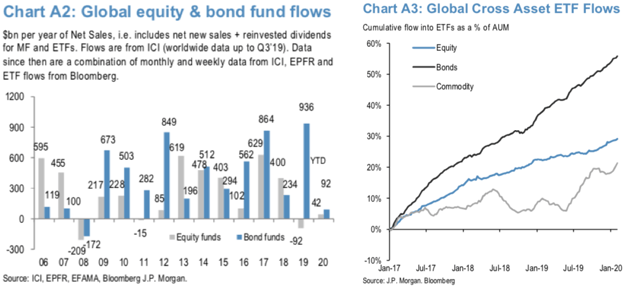
(JPMorgan)
You can delve as deeply into this as you want, but to summarize the situation, accommodative monetary policy works on both the supply and the demand side of the corporate credit market. By chasing investors out the risk curve and down the quality ladder, central banks create voracious demand for corporate issuance.
Management teams are, of course, more than happy to oblige, especially when the cost of debt is so favorable. A recent study by Deloitte found that CFOs (i.e., the people in charge of managing the balance sheet) find debt to be very attractive as a financing option. In fact, debt attractiveness rose to 87% in Q3 of 2019 and sat at 86% in Q4. That, Deloitte notes, is “the second-highest level since Q316."
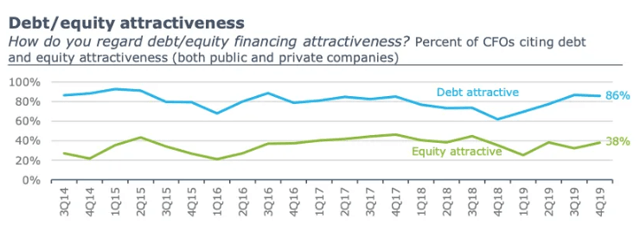
(Deloitte)
High grade spreads are sitting near 22-month lows. Investment grade credit is coming off a blockbuster year that found IG returning around 15% for investors, amid a voracious hunt for yield.
All of this goes hand-in-hand – demand begs for supply, and until it’s sated, the market’s appetite pushes yields lower, compresses spreads and drives performance for corporate credit in a world where safe-haven government bonds outside of the US yield less than zero. The end result is this:

(Heisenberg)
The proceeds from all that debt issuance are, in many cases anyway, plowed back into stock buybacks. That’s financial engineering at its “finest” or its “worst,” depending on how you’re inclined to think about things. As a reminder, the corporate bid has been the largest source of US equity demand for years.
Then there’s the quality issue. The BBB “apocalypse” story has certainly garnered its fair share of press over the past couple of years, and plenty of big names have weighed in. BBB-rated issuance has never been a higher portion of the IG universe.
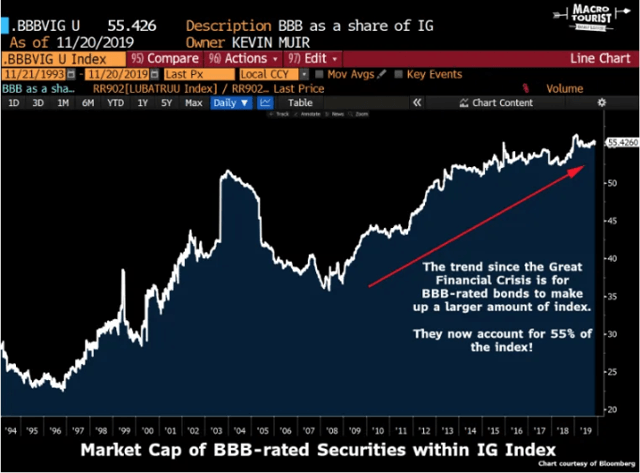
(BBG w/ annotations from Kevin Muir, of “Macro Tourist” fame)
For SocGen’s Edwards, every last bit of the above is problematic.
“It’s the quantity of corporate debt which is off the scale, as well as its low quality,” he told Bloomberg, adding that this is “where the apex of the next crisis will be.”
And I didn’t even broach the liquidity subject in any of the above. Regular readers know that's a topic that's near and dear to my (cold) heart. The following chart gives you an idea of where the problem lies (hint: the post-crisis regulatory regime has stripped the Street of its ability to warehouse risk in a pinch).
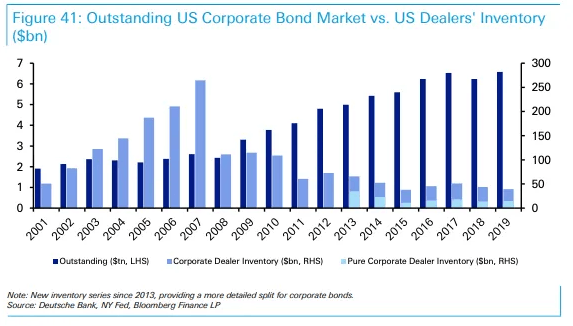
(Deutsche Bank)
Coming full circle, if the corporate debt bubble (which has been flagged by everyone from David Einhorn to Jeff Gundlach to Bill Dudley to Eric Rosengren to the IMF) does end up at the center of the next crisis, there are going to be some irritated retail investors wondering what happened to their parabolic (LQD) chart…
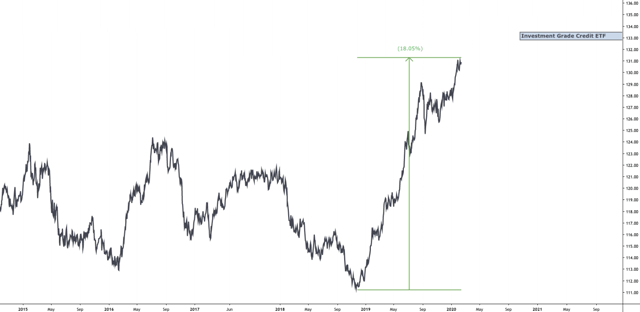
(Heisenberg)
Disclosure: I/we have no positions in any stocks mentioned, and no plans to initiate any positions within the next 72 hours. I wrote this article myself, and it expresses my own opinions. I am not receiving compensation for it. I have no business relationship with any company whose stock is mentioned in this article.